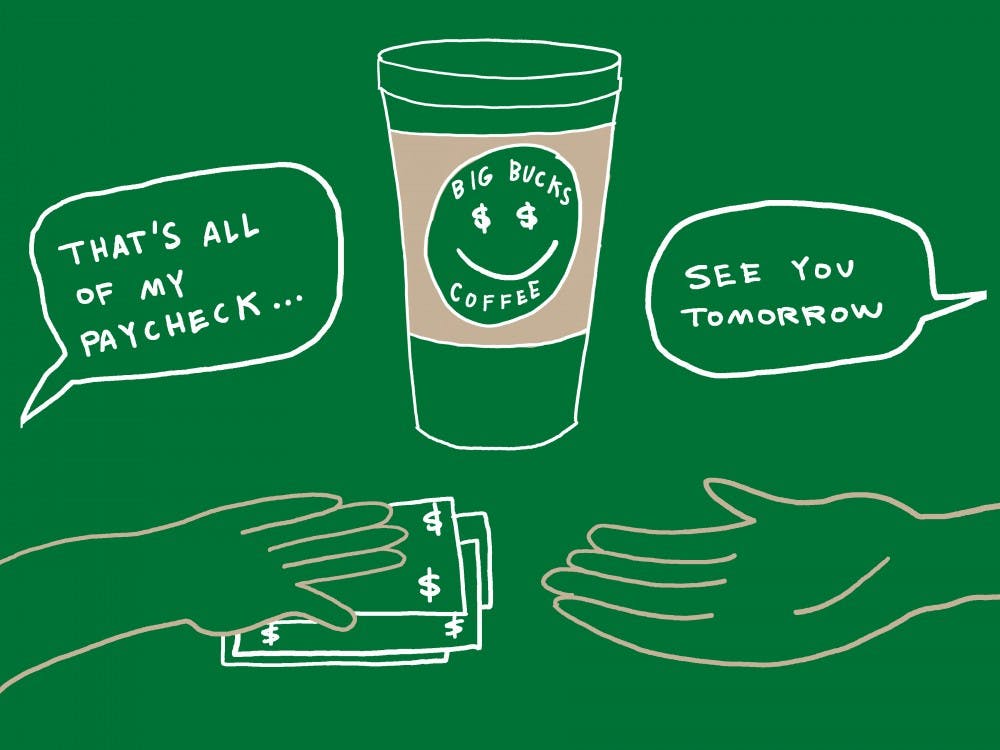As a student, coffee is an integral part of daily life. It has gotten me through multiple finals, meetings and basically every early morning — however, each time I hand over cash in exchange for coffee, I can’t help but feel like I am getting ripped off.
A regular latte can have a menu price of $3.50 but will ultimately cost you roughly $6.00 after adding an extra shot of espresso, soy milk or sweetener. Chains and independent coffee shops alike usually have a base price and charge for add-ons.
Despite these costs, there are always lines out the door at coffee shops around campus. Clearly, students are willing to pay.
“I buy coffee basically every single day, and I usually spend around $5.30,” James Hasso, a junior construction management major at ASU, said. “It’s worth the price because the coffee is better than store bought and because you can get a different atmosphere instead of working at home all the time.”
Paying an average of $5 dollars for coffee five times a week adds up to $1300 dollars a year.
“It’s a pricy habit to get into,” Jon Gray, barista at Cupz Coffee, said.
Paying around five dollars for a cup of coffee each day may feel like a rip off, but when you consider the coffee shops’ costs, a cup of coffee is not a bad deal because you are not only paying for the caffeine, but the environment and social aspect that comes along with it.
“There’s a lot of fixed costs that go into coffee businesses. The espresso machine is $15 to $20 thousand dollars, but the variable costs really aren’t that much,” Gray said.
“It costs 37 cents to pour a double shot and we charge $2.73 for that” Gray said.
Students are willing to pay a premium because they have an inelastic demand for the good. This means even with an increase in the price of coffee, students are still willing to buy it.
There are not many alternatives to coffee, and it only represents a small percentage of a person's income. Despite income changes or college debt, buying coffee is still an integral part of a college student's daily routine.
“I see my students walking around with $5 dollar polystyrene cups of coffee, there are queues out the door for it and no shortage of demand," Kym Anderson, an economics professor at Australian National University said in a Vice article. "If people are willing to pay that, it's the correct price. If people are paying $15, that is also the correct price. No matter the price, if it is being sold, it is the right amount.”
The demand not only comes from the addictive nature of caffeine, but also from the social atmosphere.
"It is not that different than going out for (alcoholic) drinks," Gray said. “It’s like a socially acceptable drug that’s not frowned upon — that’s why a lot of people come in here in pairs. People usually come in in groups rather than by themselves because they think of it more as a social outing,” Gray said.
No matter how much a cup of coffee may cost, students are lining up every day not only to wake up and get some work done, but also to relax with friends and enjoy the atmosphere. For $5 dollars, it is definitely worth it.
Reach the reporter at hehillst@asu.edu or follow @hollyhillsten on Twitter.
Editor’s note: The opinions presented in this column are the author’s and do not imply any endorsement from The State Press or its editors.
Want to join the conversation? Send an email to opiniondesk.statepress@gmail.com. Keep letters under 300 words and be sure to include your university affiliation. Anonymity will not be granted.
Like The State Press on Facebook and follow @statepress on Twitter.




